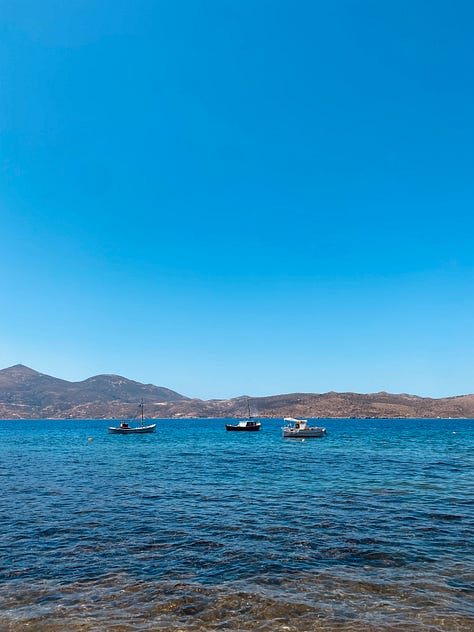Hey, hi, hello and hooray for being here!
This week we’re talking about goannas simultaneously reducing fly populations and saving the sheep farming industry, how everyday Aussie’s can join the fight against invasive pest species, the saunas dedicated to frog conservation and my distaste for some tourists.
It’s a very animal heavy newsletter this week, but that was the main news items other than more studies telling us that social media is killing teenagers and animals are much more exciting than that.
The article I wrote for the Cosmos Magazine Winter Edition is now available for purchase here. Check it out!
Your ongoing support means the world to Feral Cats HQ. Stay up to date by following along on Instagram @feralcatsmedia 🐈🫶🏼
HIGH: I’ve spent the past week having a holiday from my travels in the Cycladic Islands in Greece. It has been simply divine and I do not want to re-enter into the real world. It’s been a week full of reading and writing, eating gyros on rooftops, feeling inspired, eating pita bread and tzatziki and swimming in the Aegean Sea. Absolute perfection 🥰



LOW: American tourists. Need I say more? No. But I’m going to anyway. I think they can be summed up by my favourite quote from a park ranger in Yosemite on why it’s difficult to design a rubbish bin to keep the rubbish in and bears out:
“There is considerable overlap between the intelligence of the smartest bears and the dumbest tourists.”
Anyway, please enjoy the following examples of why American’s overseas should be fined if they say/do stupid stuff:
“Hey why does that big building have all that scaffolding on it?” - The big ‘building’ in question was the Parthenon.
Attempting to climb a castle wall because they “couldn‘t find” (translation: didn’t look) for the staircase
Yelling at a person of God because they were wearing a singlet and short shorts and said person of God told them they couldn’t enter the church wearing that
Telling a train conductor that they didn’t know they needed to buy a train ticket who responded by saying “Are you blind? We even wrote that shit in English for you.”
FERAL: I’ve been following the MONA ‘Ladies Lounge’ story since some entitled idiot man took the gallery to court because he wasn’t allowed into the women only space. Welcome to feminism, you dick.
Anyway, the latest update is that the actual fucking Picasso paintings that were in the ladies lounge, have been put up in the female bathrooms. Fucking iconic MONA, well done.
Let’s talk about the science news.
In a nutshell:
Goannas are saving South Australian farms fly problem
Frog saunas have been developed to save frogs from a deadly fungus
Everyday Australian’s can help the fight against invasive species
Ecology and Evolution: Aussie goannas munching maggots could help beat the blowfly
Goannas have been the talk of the town recently! (When I say town, I mean this publication.)
If you don’t have a good stomach, I’d suggest not reading this while eating. You might lose your lunch.
A new study has found that the endangered heath goanna could save Aussie farmers with the issue that is the ✨fly✨.
Goannas are the largest native scavengers in Australia, and they’re eating maggot-ridden animal carcasses on South Australian farms.
This is the very first research paper to show how important large reptiles are as scavengers in Australia.
Flies are more than just annoying little fuckers, but they can lay their eggs in sheep’s bums which hatch into flesh eating maggots which eats the sheep’s bum and then (in most cases) the bum-less sheep dies. Flies cost sheep farmers $280 million every year.
The heath goanna, which can grow up to 1.5 metres in length, act as the clean up crew; eating the dead carcasses and stopping the maggots morphing into flies and spreading even further.
The study was undertaken on Guuranda Country (Yorke Peninsula, SA); an area where 90% of native mammals are already extinct. The researchers found goannas to be much better at controlling flies than invasive species such as foxes and cats (another reason to hate feral cats).
The goannas are not only saving the sheep, but the researchers suggest that if we boosted the populations of goannas in the area, it could restore the natural ecosystem and assist in allowing small mammals to thrive.
Future conservation work should be aimed at removing the invasive species that are useless at removing flies, and also increasing the number of goannas to create an all around healthier ecosystem.
Nature: Hotspot shelters stimulate frog resistance to chytridiomycosis
A new study has developed a method to save frogs from the devastating chytrid fungus; a disease that has driven multiple frog species to extinction.
The Aussie green and golden bell frog (Litoria aurea) is only found in 10% of its original range, due to the impact of the chytrid fungus.
Researchers developed frog saunas made of bricks and PVC pipe that frogs can hop into and heat their body to a temperature that causes the fungus to fuck off.
Data shows that frogs in these hotspots had a significant reduction in the chytrid infections.
Not only this, but frogs who survived an infection developed an acquired immunity so that they’re more resistant in the future.
This research is the first ever to provide a tangible way to protect frogs against the chytrid fungus, more than 25 years after it was found to be a major cause of frog population collapse.
Unlike many strategies to save animals, this strategy is inexpensive, and with a little help, could be massively upscaled to protect many of our Aussie frogs.
Hooray for saving the frogs!
Wildlife Research: How everyday Australians are helping in the fight against invasive species
The Atlas of Living Australia (ALA) is exactly what it sounds like; an online atlas of all of the living species in Australia.
The data from ALA comes from a variety of citizen science bases where anyone can contribute sightings of a plant or animal, which are then validated by an expert.
A new study has assessed the effectiveness of a new ALA feature, where emails are sent to alert the authorities (I’d like to petition it be called the Feral Cat Police) if an invasive species has been spotted in an area with high levels of endemic or endangered species.
Researchers have determined that these alerts allow management people to have a faster and more targeted response to invasive species or biosecurity threats.
As cats (and all of the other invasives) continue to take over Australia, it’s really cool to see how everyday people with no formal science training can contribute to killing the cats (and all of the other invasives).
That’s the end of the newsletter, see you next week!
If you enjoy reading Feral Cats, be sure to like or comment on the post. Or give it a share to tell all your friends!
Stay feral,
Cat 🐈






